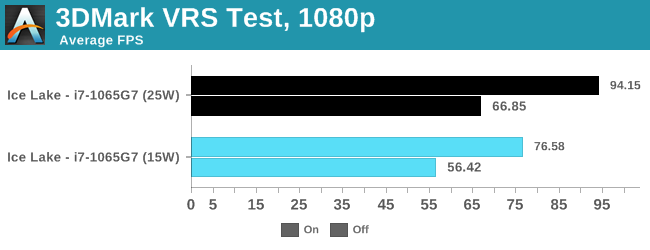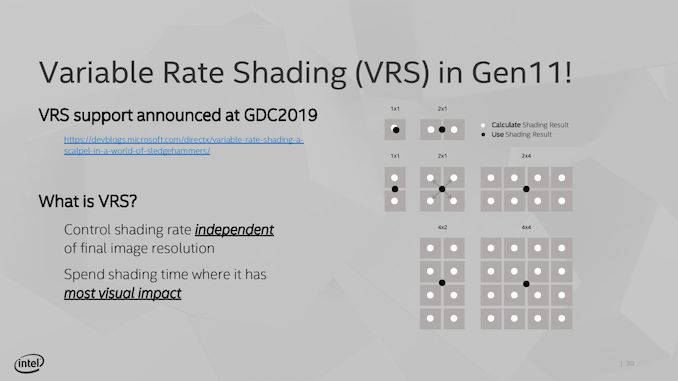The Ice Lake Benchmark Preview: Inside Intel's 10nm
by Dr. Ian Cutress on August 1, 2019 9:00 AM EST- Posted in
- CPUs
- Intel
- GPUs
- 10nm
- Core
- Ice Lake
- Cannon Lake
- Sunny Cove
- 10th Gen Core
Gaming Results (15W and 25W)
One of the biggest changes to the Ice Lake design is in the integrated graphics – Intel is now giving more focus and more die area to graphics, something it has arguably been neglecting for several years now. With Ice Lake, we move to a Gen11 graphics architecture, which is almost like the previous Gen9.5 but now with added support for variable rate shading (VRS), moving from 24 EUs to 64 EUs, and memory support up from LPDDR3-2133 to LPDDR4X-3733.


World of Tanks is a very CPU driven benchmark, and having the extra frequency of the 25W processor does help here. We're getting a sizeable uplift from Whiskey Lake, due to the extra EUs and memory frequency.


Our Final Fantasy test seemed to regress in 25W mode, although still within the noise. This test is still GPU bound, so adding the extra TDP to the CPU didn't actually help much. However, comparing to the Whiskey Lake integrated graphics, we've got over a 2x speedup.


Similarly with Civilization, with what is normally our 'IGP' settings, we are still GPU limited here.
One of Intel's newest features is Variable Rate Shading.
If developers add the option, soon to be an easy checkbox in Unity and Unreal, the game can decide to control the rate at which it shades pixels, from calculating every pixel down using one result across a 4x4 grid, to save compute power. Currently the only way to test this is with the 3DMark functional demo.

The new VRS test in 3DMark is designed as a feature test to show the potential uplift effect from enabling variable rate shading within a game. In both 15W and 25W modes, the data saw a good uplift, and we seemed to get more out of the 25W mode than the 15W mode.














261 Comments
View All Comments
Alistair - Friday, August 2, 2019 - link
I find partisanship frustrating. You are absolutely right that we just got IPC but bad frequency from both AMD and Intel, so it is nice to see the IPC side of things, but we should be able to criticize Intel without someone brushing us off as being AMD supporters or some nonsense. The new products (these mobile chips in particular) are not very good. Still should be polite to Ian Cutress, he does do fantastic work.I guess I didn't get the memo that no 6 core ultra low voltage parts were coming. I'm very disappointed in the very tiny gains this year. I'm waiting for a good 6 core CPU at 25 watts.
0ldman79 - Friday, August 2, 2019 - link
Welcome to the Internet, where voicing an opinion on anything gets you labeled as a fanboy/X political party.Every good forum needs a block button... lol
eva02langley - Friday, August 2, 2019 - link
The difference here is that Ryzen 3000 clock higher than 2000.... little difference...Alistair - Friday, August 2, 2019 - link
Absolutely at least AMD's chips clock the same or an extra 100 mhz higher, Intel's new chips clock several hundred mhz slower, making them really poor this year. Making 6 core options more important than ever. 4 cores in this situation are really useless without a large price drop.0ldman79 - Friday, August 2, 2019 - link
This is also the efficient line of chips. Last I heard they got the efficient transistor design going but not the high performance one.They may clock higher, they may be limited by the architecture. Dunno. Could entirely be because they packed the chip too tight, the hotspots that spike the Zen 2 temps may actually be causing significant issues with 10nm. In this case the whole "transistors per sq mm" argument may become moot. Packing them in so tight they can't displace heat properly is a bad thing and may be what is happening here.
HStewart - Thursday, August 1, 2019 - link
I think you to give both Ian and Intel more credit, there is no doubt that Intel has some struggles with going to 10nm but this is first part of the recovery. The results here are extremely impressive especially that these products are low power laptop and not large desktop gaming machines.It would be interesting to compare the new Dell XPS 13 2in1 against existing dell XPS 15 2in1 in which the 15 2in1 has higher power cpu and GPU. I would say it likely with results here, the 13 2in1 has chance of beating the 15 2in1
It going to be interesting to see what 45W laptops are like and the desktop chips on Sunny Cove.
eva02langley - Friday, August 2, 2019 - link
Give Intel credit... HAHAHAHAHAHA.... they don't deserve any credit. These directors just want to have the stock rise to have a better pay check. Everything they do is biased with this in mind.unclevagz - Friday, August 2, 2019 - link
Public company senior management want stock price rises for bigger bonuses, in other news water is wet.Xyler94 - Sunday, August 4, 2019 - link
Water cannot be wet, funny enough. "Wet" is the property of an object that has come in contact with a liquid, most notibly water, since water cannot be I contact with itself to cause wetness, water is therefore, not wet. :PPhynaz - Friday, August 2, 2019 - link
Dumbass